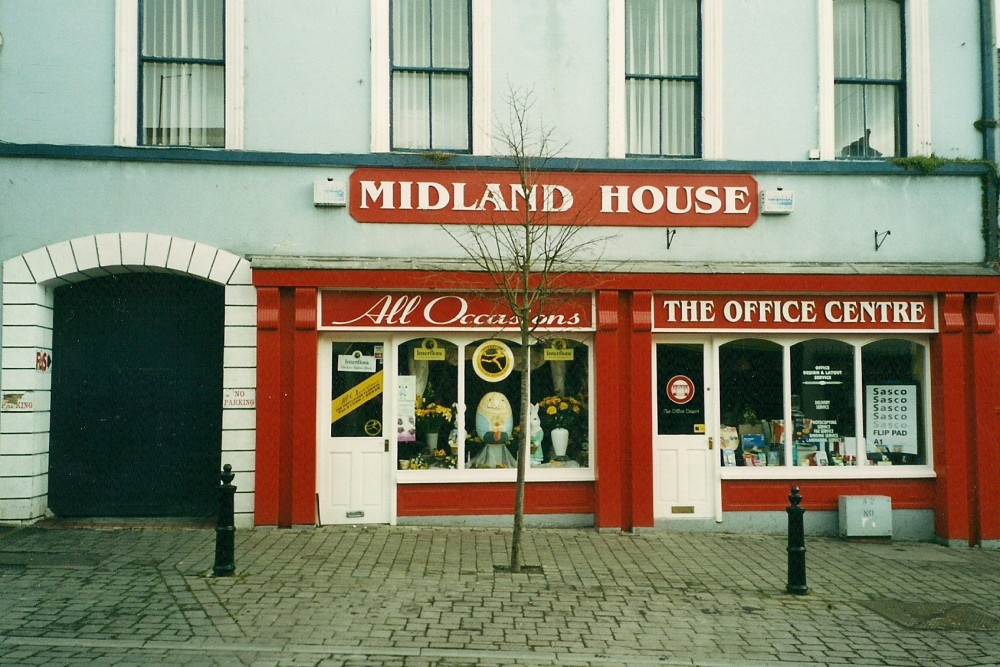
According to the Museum & Heritage Section of An Post, there was a Post Office in Maryborough as far back as 1710, but it had no information about its location. [Prior to 1840, incidentally, the cost of a letter was based on the distance it had to travel by mail coach and the number of pages it contained.] From the late 1830's, John Miller was Postmaster in the town; he died in 1870, aged 84, and was succeeded by - his son? - Thomas Miller. In the 1850's John Miller was living two doors down from here, but his place of work, so far, remains a mystery. While it doesn't pinpoint the exact location, a map of Maryborough published in 1889 places the Post Office in the Lower Square/Bridge Street area. Any information welcome (on a postcard please!). In the 1880's, George Marshall, former draper and stamp distributor, was the town's postmaster. [In March 1889, The Nottingham Evening Post printed his letter endorsing Dr Richter's Expeller which purported to cure everything from gout and rheumatism to tootache and influenza. It evidently worked for Mr Marshall: "Before I had used half the bottle I was able to walk and put on my boots, which I had not done for three weeks"]. Sometime in the 1890's, the above building replaced an earlier one - occupied, in the 1850's, by Miss Julia Clare (probably related to John and Redmond Clare, a publican and woollen draper respectively) - and the Post Office (including the postmaster's residence) was opened here. In the middle of that decade, George Marshall was succeeded by Tipperaryman Richard Plunkett Fennell who was prominent in many of the town's social spheres; President of the Vincent de Paul Society, well-known athlete and GAA member, Secretary of Maryborough Cycling Club and Member of the Town Commission, In 1891, in his capacity as member of the Queen’s County Gaelic Committee, he proposed that the committee ”condemn the action of Mr C. S. Parnell in forcing a conflict among the Irish people by refusing to comply with the request of those pure-souled patriots John Dillion and William O’Brien to resign his claim as Chairman of the Irish Parliamentary Party, a position from which he has been deposed by the majority of his colleagues.” His proposal - as prolix to today's readers as it is biased - was carried by the Committee. He was the first Catholic postmaster in the town and The Nationalist pulled no punches when it reported (12/01/1895) that this was achieved despite “the bitter opposition and wire-pulling of the local Freemason Lodge. The fight for the office resolved itself into a fight between Toryism and Nationality. No more unpopular appointment could be made as far as the Lodge is concerned, for no man is more detested by the Tory flunkeys than the new postmaster”. In 1901, Mr Fennell was living here with his wife Mary Ellen and infant daughter of the same name. He was postmaster until 1928 and, at the time of his death, aged 82, was living in Church Street. One of his grandsons, incidentally, is none other than that popular man-about-town Greg Fennell whom we've already met as my erstwhile partner in musical crime. The Post Office moved to Coote Street in 1972, and to its present, totally inadequate premises - Any chance of rostering more clerks, or providing seating for elderly people forced to queue? - in Lyster Square in 1994. A final quick note: In the mid-19th century, post arrived in the town by train 'from all parts', twice a day, six days a week. After lying vacant for some months, the All Occasions premises became occupied by the Dressmaker's Wardrobe in June 2018. In February 2024 that business moved to No. 86, just across the street and, months later, was replaced here by The King Traditional Turkish Barber.
|
 |
 |
| HOMEPAGE |